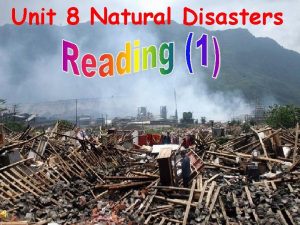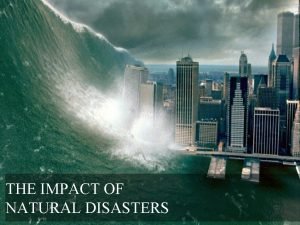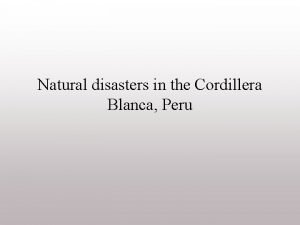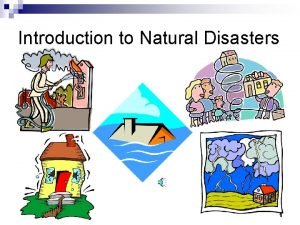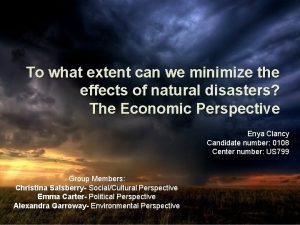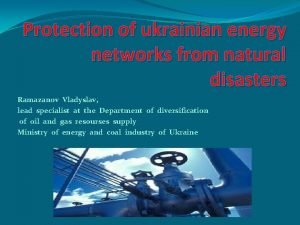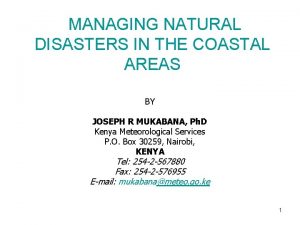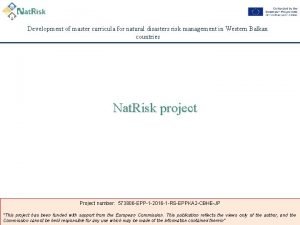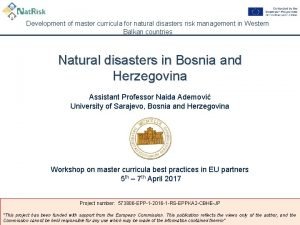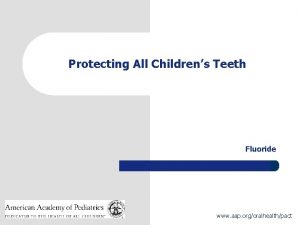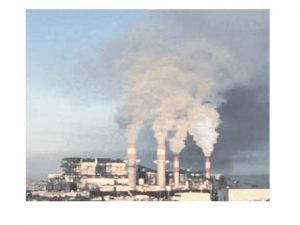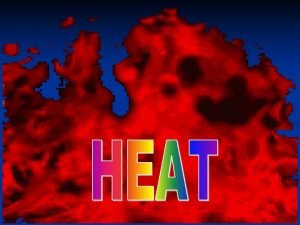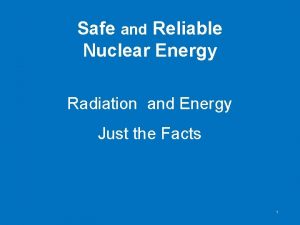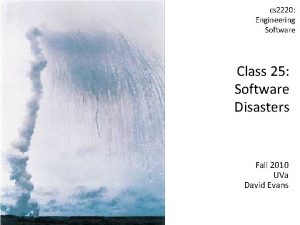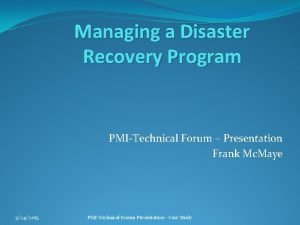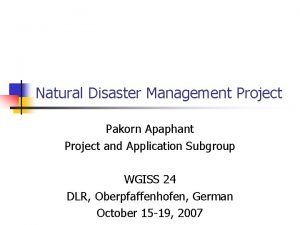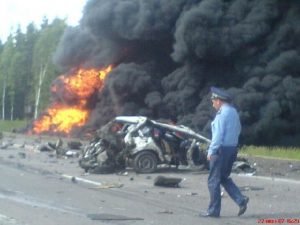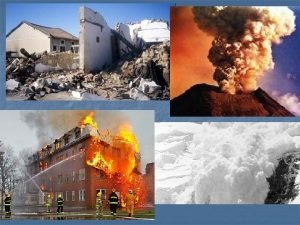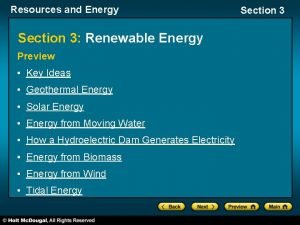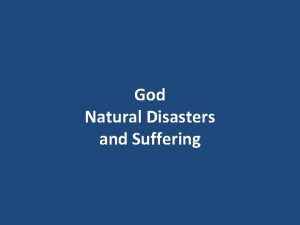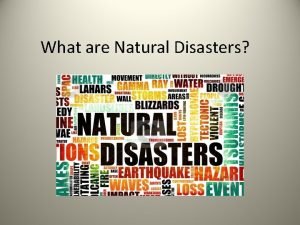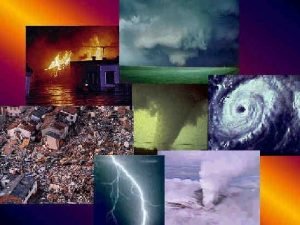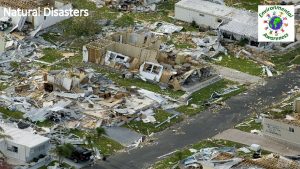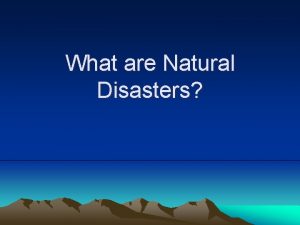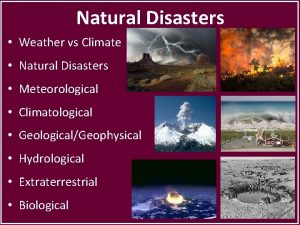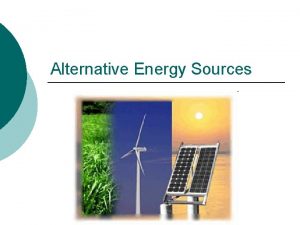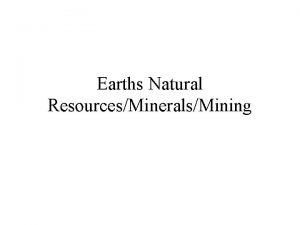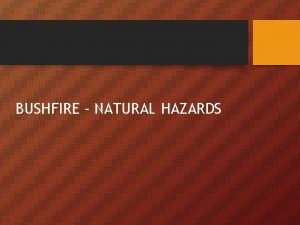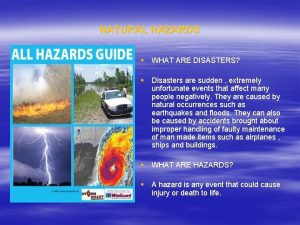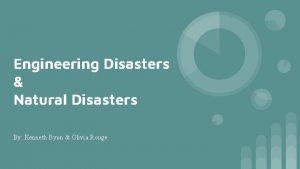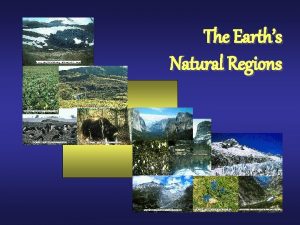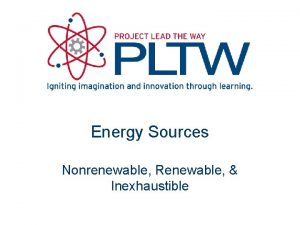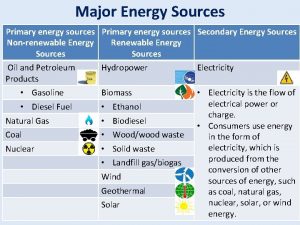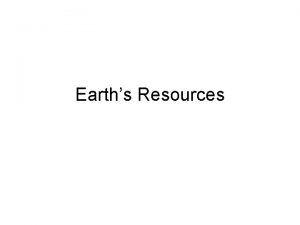Natural Disasters Earths Energy Sources and Systems Earths







































- Slides: 39

Natural Disasters • Earth’s Energy Sources and Systems • Earth’s Internal Structure • Introduction to Plate Tectonics

Earth Systems

Consequences of a “dynamic” Earth • Earthquakes • Volcanoes • Mountain Building

Energy Sources for Natural Disasters 1. Gravity The planet Earth generates a pull on every other object in the entire universe! It is this pull that creates weight. It is this pull that causes an object to fall. Such a pull is called a force. The force that causes an object to fall is the force due to gravity. Gravity on the earth is constant. . . All objects fall equally fast. If we think about this and take it a bit further we come to the realization that the force of gravity is what causes the acceleration due to gravity. The gravitational acceleration of the Earth (9. 8 m/s 2)

Gravity and Newton’s Law F = ma (or F=mg) • A force applied to an object causes an acceleration in that object. The force of gravity is what causes the acceleration due to gravity. (9. 8 m/s) • The more material an object has or the greater its mass, the greater the force that pulls on it. • The net force acting on an object is equal to the product of the object's mass and its acceleration. Consider free fall of an object due to gravity. The force of gravity is proportional to mass m, so we can write F = mg, where g is the acceleration of gravity, directed downwards. .

Energy Sources for Natural Disasters 1. Gravity 2. Earth’s Internal Heat

Internal Sources of Energy Three Sources of the Earth’s Internal Energy (Heat) 1. Impacts of asteroids 2. Decay of radioactive elements 3. Gravitational contraction

Origin of the Solar System B A Rotating cloud of dust and gas gathers due to gravitational forces. Rotating mass contracts and flattens with most of the mass in the center. D C Star ignites to form the sun. Gases blown to outer planets. Planets form by the accretion of stony and iron meteorites as well as ice particles.


Early Earth is hot, hot!!! Heat Sources • • Gravitational collapse Impact Energy • Radioactive decay

Mantle Convection Drives Plate Motion internal heat engine Moving plates cause EQ’s and volcanoes!

Energy Sources for Natural Disasters 1. Gravity 2. Earth’s Internal Heat 3. Solar Energy

Solar Energy Flow

Hydrologic Cycle

Uneven Distribution of Solar Energy Causes Severe Weather

Natural Disasters • Earth’s Energy Sources and Systems • Earth’s Internal Structure • Introduction to Plate Tectonics

Chemical Differentiation of the Earth

Differentiation of the Earth……. produces Earths’ internal structure Crust, Mantle and Core

Radius = 6370 km Distance to Core is ~1/2 the radius (2900 km depth)

Earth Structure The earth today is the product of over 4. 5 billion years of differentiation into layers of varying density. The 8 most abundant elements in the earth are • iron (Fe), • oxygen (O), • silicon (Si), • magnesium (Mg), • sodium (Na), • calcium (Ca), • aluminum (Al) and • potassium (K),

Earth Structure - Density Stratified Layers Earth’s Core The earth’s core is composed of two parts, the inner core and the outer core. The inner core is SOLID iron (Fe) and nickel (Ni) and the outer core is LIQUID Fe and Ni.

Earth Structure - Density Stratified Layers Mantle Chemically the mantle is composed of Fe, Mg, Si and O. (ULTRAMAFIC composed of Fe, Mg silicates) The mantle extends from roughly 502900 km below the earth’s surface.

Earth Structure - Density Stratified Layers Crust Is composed of two types: Oceanic Crust (below ocean) which is 710 km thick also made of Si, O, Fe and Mg. (MAFIC composed of Ca, Fe, Mg silicates) Continental Crust which is 20 -70 km thick made of Si, O, Fe and Mg. (FELSIC composed of Ca, Na, K silicates)

Earth Structure - Density Stratified Layers Crust vs. Mantle The mantle contains MORE Fe and Mg than the oceanic crust and the oceanic crust contains MORE Fe and Mg than the continental crust. Because Fe and Mg are DENSER elements, the mantle is denser than the oceanic crust and the oceanic crust is denser than the continental crust. Assume the two blocks to the left are of equal volume and they are composed of the same material (red atoms). If density=mass/volume which box has the higher density? Density can also vary from element to element

Earth Structure - Layers of Different Strengths The earth is layered with respect to physical properties. The crust and the upper part of the mantle is called the LITHOSPHERE and it is RIGID, BRITTLE and behaves ELASTICALLY. The part of the mantle directly below the lithosphere is termed the ASTHENOSPHERE which behaves like a PLASTIC - a solid that flows.

Upper Mantle and Crustal Structure Oceanic Continental Moho Lithosphere (or plate) = crust + uppermost, rigid part of the mantle

Natural Disasters • Earth’s Energy Sources and Systems • Earth’s Internal Structure • Introduction to Plate Tectonics

Plate Tectonic Theory • 6 large plates (e. g. , Pacific Plate) • 7 -10 small plates (e. g. , Arabian Plate)

Mantle Convection Drives Plate Motion internal heat engine Heat Sources • • Original heat from formation of the Earth Radioactive decay of U, Th, and K in the core and mantle

Plate Velocity Up to ~17 cm/yr

Types of Plate Boundaries 1. Divergent 2. Transform 3. Convergent

Divergent Boundary

Divergent Boundary Iceland, Mid-Atlantic Ridge

Transform Boundary

Transform Boundary San Andreas Fault, CA Pacific Plate North American Plate

Convergent Boundary

Convergent Boundary Tibetan Plateau, Himalaya Mts; SE Asia

Convergent Boundary Andes Mts, South America

 Natural hazards vs natural disasters
Natural hazards vs natural disasters Unit 8 natural disasters
Unit 8 natural disasters Natural disasters listening
Natural disasters listening Social impacts of natural disasters
Social impacts of natural disasters Cordillera natural disasters
Cordillera natural disasters Disaster definitions
Disaster definitions Ancient natural disasters
Ancient natural disasters Three natural disasters
Three natural disasters Conclusion of natural disasters
Conclusion of natural disasters Conclusion on disaster management ppt
Conclusion on disaster management ppt Positive effects of earthquakes
Positive effects of earthquakes Natural disasters introduction
Natural disasters introduction Natural disasters
Natural disasters Natural disasters
Natural disasters Natural disaster unit 9
Natural disaster unit 9 Ancient natural disasters
Ancient natural disasters Sources of natural heat
Sources of natural heat Print and web sources
Print and web sources Important water resources
Important water resources Energy energy transfer and general energy analysis
Energy energy transfer and general energy analysis Energy energy transfer and general energy analysis
Energy energy transfer and general energy analysis Chapter 8 emergency care first aid and disasters
Chapter 8 emergency care first aid and disasters Dean fluorosis index
Dean fluorosis index Forbes method in pharmaceutics
Forbes method in pharmaceutics Formation of nitrogen dioxide
Formation of nitrogen dioxide Natural source of heat
Natural source of heat Nitrogen content in soil
Nitrogen content in soil Sources of radiation
Sources of radiation Natural capital and natural income
Natural capital and natural income Aqa english language paper 2 rail disasters model answers
Aqa english language paper 2 rail disasters model answers Software engineering disasters
Software engineering disasters Man made disasters conclusion
Man made disasters conclusion Most historians agree that military disasters
Most historians agree that military disasters Types of disasters
Types of disasters What are disasters
What are disasters Crash that is speeding
Crash that is speeding Accidents & disasters
Accidents & disasters Disaster management definition
Disaster management definition Man-made disasters introduction
Man-made disasters introduction Section 3 renewable energy sources
Section 3 renewable energy sources

